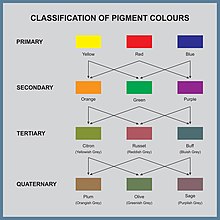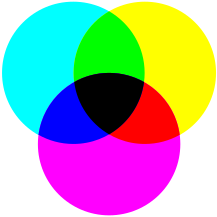Color (or colour in Commonwealth English; see spelling differences) is a property of light.



The following are the most common color names:
|
|
Primary colors can be mixed to make other colors. Red, yellow, and blue are the three traditional primary colors. The primary colors for television screens and computer monitors are red, green and blue. Printers and paints use magenta, yellow, and cyan as their primary colors; they may also use black. Sometimes this set of colors is simply called red, yellow, and blue.
People who can not see colors or have a distorted sense of color are called color-blind. Most color-blind people are male.
Colors are sometimes added to food. Food coloring is used to color food, but some foods have natural colorings, like beta carotene.
When something has no color, it is called transparent. An example is air.
The science of color is sometimes called chromatics, colorimetry, or simply color science.
A translucent material is not the same as a colorless material because it can still have a color, such as stained glass.